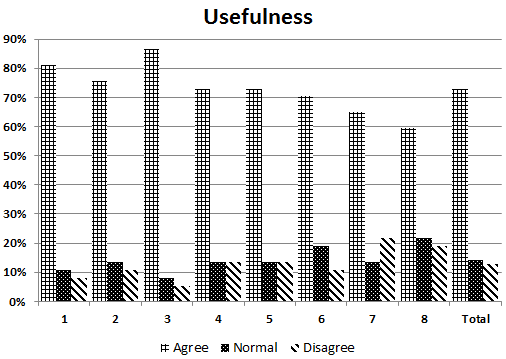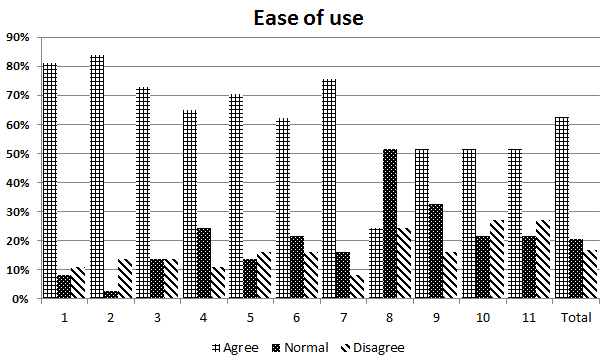The Important of Online Learning_Part 3
III. RELATED RESEARCH
Based on the previous research about usability evaluation, it already stated that usability is one of technique to measure e-learning systems’ efficiency. It also can be used to evaluate the effectiveness of tools and technology in terms of support the users. It also stated that many academic institutions prefer to build their own LMS, so it is important to measure the usability of LMS. Other research also stated that perceived usability affects great students’ learning effectiveness and the whole learning experiences.
Another previous research identifies the influence of visual e-learning website on learning motivation. The result of investigation stated that visual appearance on e-learning website affects the presentation of information for the learners, which is influence 33.5% of learners’ motivation. So, the higher education should emphasize visual preparation of information and instruction design when creating an e-learning website. Previous research used three models of questionnaire based on two standards questionnaires, which are Systems Usability Scale (SUS), Usability and User Satisfaction Questionnaire and Web-Based Learning Environment Instrument. Authors apply USE questionnaire model to gather data from respondents, which is different than other previous research and can be references for other future research.
According to previous researches, it is important to assess e-learning usability in Binus University, which is the University that attempt as one of the pioneer of LMS in Indonesia. The evaluation of e-learning usability in Binus University can be role model for another university in Indonesia.
IV. RESULT AND DISCUSSION
- Questionnaires Recapitulation
From the USE questionnaire, which measure usefulness, ease of use, ease of learning, and satisfaction, here are the details of questionnaires’ recapitulation.
Usefulness
Fig. 1. Results Feedback “Usefulness” use USE Questionnaire
Usefulness consists of (1) It helps me be more effective, (2) be more productive, (3) useful, (4) more control over the activities in my life, (5) to accomplish easier to get done, (6) saves my time, (7) meets my needs, and (8) It does everything I would expect it to do.
All the results showed excellent usability. Binus Online Learning is very useful (86%), helping the learning process more effective (81%), more productive (76%), easy to do (73%), can help control the activities in the learning process (73%), saves time (65%), and in line with expectations (59%).
1. Ease of use
Ease of use consists of (1) It is easy to use, (2) simple to use, (3) user friendly, (4) requires the fewest steps possible to accomplish what I want to do with it, (5) flexible, (6) effortless, (7) I can use it without written instructions, (8) consistencies, (9) both occasional and regular users would like it, (10) I can recover from mistakes quickly and easily, and (11) I can use it successfully every time.
Fig. 2. Results Feedback “Ease of use” use USE Questionnaire.
Results of the ease of use shows that Binus Online Learning simple to use (84%), easy to use (81%), can be used without written instructions (76%), user friendly (73%), flexible (70%), slightly steps to do what he wanted to do (65%), quite a bit of effort (62%), both occasional and regular users would like it (51%), I can recover from mistakes quickly and easily (51%), I can use it successfully every time (51%) and less consistent (24%). From the result, the authors can conclude that even though 84% users stated that Binus Online Learning is simple to use, but still 24 % users stated that Binus Online Learning is less consistent. Consistency is important part from online learning because it measures the consistency of materials and the use of the website. In this case, Binus Online learning should improve the consistency.
References :
- Thuseethan and Kuhanesan (2014) ”Usability Evaluation of Learning Management Systems in Sri Lankan Universities”, Department of Computing and Information Systems, Sabaragamuwa University of Sri Lanka, Sri Lanka and Department of Physical Sciences, Vavuniya Campus of the University of Jaffna, Sri Lanka.
- Konstantina Orfanou, Nikolaos Tselios, and Christos Katsanos. (2015)
- Perceived Usability Evaluation of Learning Management Systems: Empirical Evaluation of the System Usability Scale. International Review of Research in Open and Distributed Learning. Volume 16, Number 2, 227
- Andi Aulia Hamzah, Achmad Syarief dan Ifa Safira Mustikadara. (2013). Analisis Kualitatif Tampilan Visual Pada Situs E-Learning. Fakultas Seni Rupa dan Desain (Univ Kristen Maranatha) dan Faculty of Visual Art and Design (ITB), ITB J.Vis. Art & Des. Vol. 5, No. 2, 2013, 176-194.



